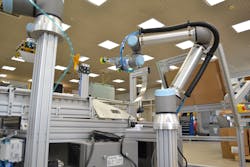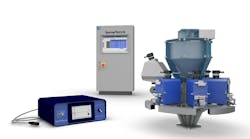Called “a new breed of robots” by the International Federation of Robotics, collaborative robots, or cobots, can operate safely alongside humans without fencing. In a 2020 report, the IFR defines four stages of collaboration. The stages are:
- Coexistence: No fencing, but no shared workspace
- Sequential cooperation: Robot and worker both active in the workspace, but movements are sequential
- Cooperation: Robot and worker work on the same part at the same time — both in motion
- Responsive collaboration: Robot responds in real-time to movement of worker
The most common of the interactions between humans and cobots involve the first two stages — in which machines and humans work separately or carry out consecutive duties, according to a 2022 academic paper, “The Expanding Role of Artificial Intelligence in Collaborative Robots for Industrial Applications: A Systematic Review of Recent Works.”
The academic report suggests that greater interactions might be possible in the future, as artificial intelligence (AI) develops. For example, it says, “There is growing interest in creating a collaborative workspace where people and robots can work cooperatively because of the supportive nature of their abilities. These diverse elements of the industrial sector’s dynamic nature and the existing deficiencies in analyses serve as a high impetus for the development of AI-based HRC.” HRC stands for human-robot collaboration.
Experts also use more general definitions for cobots. For example, the academic paper makes the distinction that “cobots help employees, whereas robots take their place.” Meanwhile, Ken Fordyce, an AI specialist who’s retired from IBM, said a cobot is “a robot that can learn multiple tasks so it can assist human beings. In contrast, autonomous robots are hard-coded to repeatedly perform one task, work independently and remain stationary. [Cobots] are designed to work alongside and assist human employees, all the while making sure they don’t cause any harm to us carbon-based lifeforms.”







